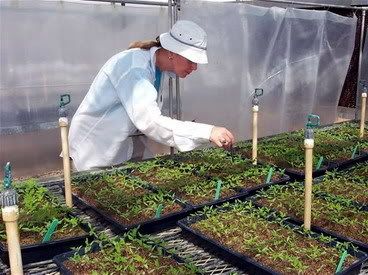Research by Downton,
Bjorkman and Pike (1980) studied the effects of increasing the C02 level using Nerium oleander, a drought-resistant evergreen shrub, and Tidestronia oblongifolia, a summer-active perennial native to the floor of Death Valley, USA. They found that while increased photosynthesis enhanced dry matter production and flower production, water use efficiency was greatly increased. For N. oleander grown at double normal C02 levels, water efficiency also doubled; for T obiongifolia grown at triple C02 levels, water efficiency tripled, although C02 enrichment did not enhance growth significantly. Their research did show that such plants can be grown in areas currently too arid for agriculture. Of greater significance, however, is the increase in dry matter production in areas where plants already grow.
Over the past decade there have been numerous studies on the effect Of C02 enrichment, but growth and yield rates have varied from model to model. For tomatoes, Slack (1986) showed a 30% increase in growth and yield, while Yelle (1987) reported a 36% increase. These results support earlier studies by Wittwer and Homma (1969) who, in tomato seedlings, reported accelerated growth rates, root growth promotion, and earlier flowering and fruiting. Other studies have shown a 31% weight increase in lettuce when exposed to 1600 ppm Of C02, and a 23% increase in fruit weight for cucumbers exposed to 1000 PPM C02.
Hydroponic Research
5:25 PM
ThanateTan







